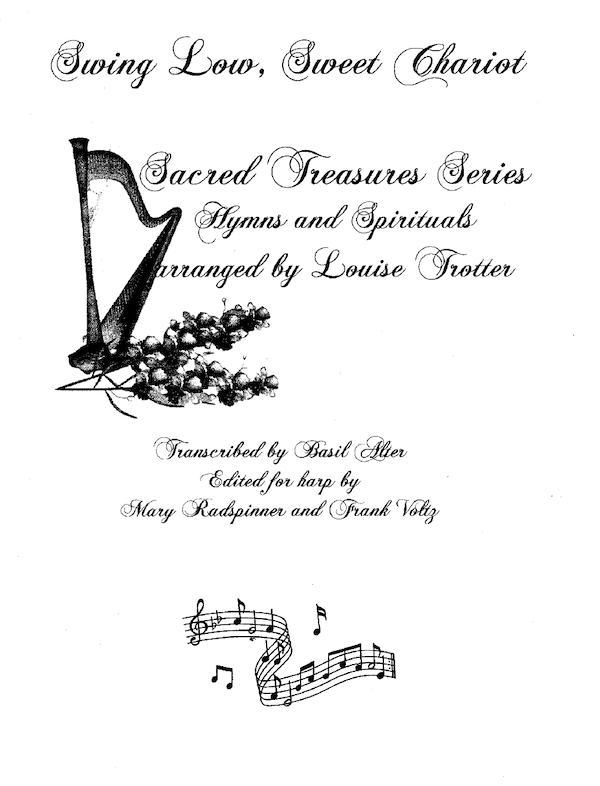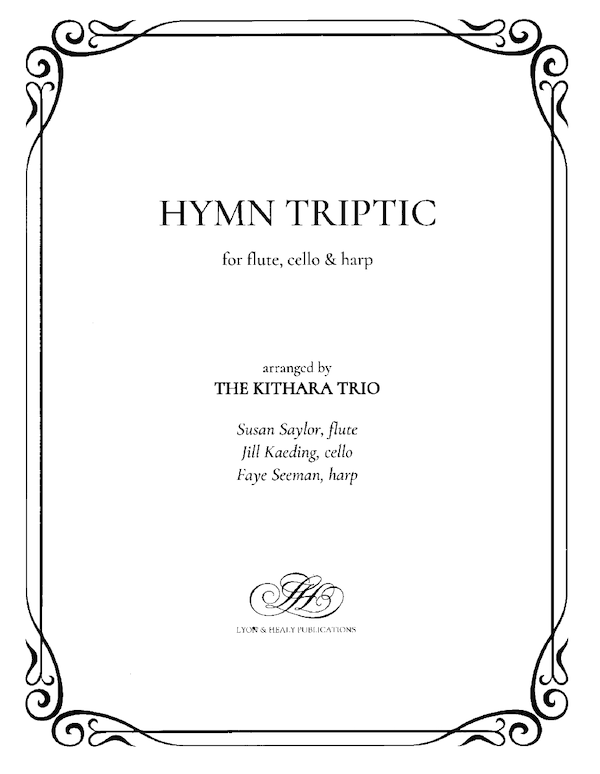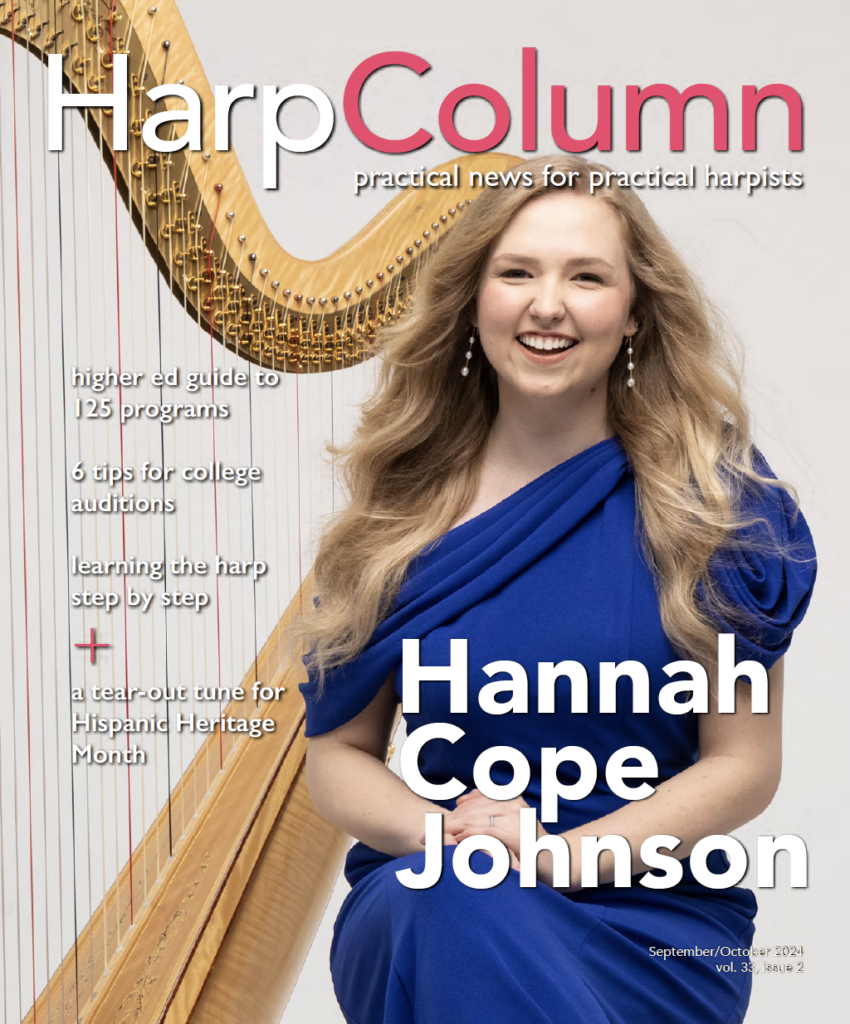


From l. to r.: The late Louise Trotter’s “gorgeous” arrangement of “Swing Low Sweet Chariot;” a collection of hymns for flute and harp by Joyce Weaver are sight-readable for intermediate players; and Hymn Triptic offers a “creative” trio arrangement.
Harpists are always in demand for church gigs, so there is also a need for good hymn arrangements. There are several worthy publications that deserve closer review.
Afghan Press has published a gorgeous arrangement by the inimitable, late Louise Trotter of “Swing Low, Sweet Chariot” for solo pedal harp. This was transcribed as played by Trotter on the album, Sacred Treasures, by Basil Alter and edited by Mary Radspinner and Frank Voltz.
It starts out in the key of E-flat and in 4/4 time. It’s a pretty straightforward arrangement with mostly a single-note melody enhanced by some luscious chords for the first verse. The second verse features a left hand melody accompanied by glisses in the right hand. There is a modulation to the key of F and a meter change to 12/8. The left-hand accompaniment is now a stride bass and the right hand embellishes the melody with a little improvisation. The improv and jazzy harmonies continue through to the end, delivering a toe-tapping rendition suitable for a gospel revival.
All pedal changes are clearly marked in the center of the staff, and the one page turn is well-planned. The type-setting is easy to read. There is no fingering other than a suggestion of which hand to use on an arpeggio. It sounds more difficult than it is, and solid intermediate players should find it very accessible. This is classic Louise. How can you resist?
If you want something to play with flute (or other C instrument), Joyce Weaver offers a nice collection titled Three Old Hymns arranged for Harp & Flute. The music is available in a spiral bound print version or as a PDF download from the publisher, Afghan Press.
A separate flute score is included, but the flute parts are also bound within the spirals so the flute parts will never end up missing in action. The flute part is also included on the harp score. There are no pedal or lever changes in any of the harp parts, so they are suitable for pedal or lever harp. Hymns can be short, so it’s a plus that Weaver has developed the arrangements to offer variety throughout several verses.
The first selection in this trio is “Traditional Swedish Melody,” a.k.a. “How Great Thou Art.” It is in 4/4 and C major. The flute starts with the melody and the harp provides an arpeggiated style of accompaniment. The harp plays the second verse solo. The harp continues to carry the melody in the third verse while the flute plays a pretty countermelody. The flute resumes the melody for the last verse, but an octave higher than before.
The second selection is actually a medley of “Fairest Lord Jesus” and part of “Jesus Loves Me.” It is in 4/4 and D major. The harp takes the melody while the flute harmonizes on the first half of the tune. The flute takes over the melody and finishes the first verse accompanied by the harp. The harp transitions into a solo version of the chorus to “Jesus Loves Me,” then switches back to “Fairest Lord Jesus.” In the last verse, both instruments improvise a little and harmonize together. There is one awkward page turn.
The last hymn in this assortment is “Let All Things Now Living” in 3/4 and G major.
The flute is indicated as optional for the first eight measures, or both musicians can play the melody in unison, with the harp adding octaves and tenths in the left hand. When the opening phrase repeats, the flute assumes the melody while the harp plays resonant chords. In the second and third verse, the flute alternates between playing harmony and a lovely countermelody mixed in with a little melody. The harp plays mostly melody. It’s a very appealing arrangement with the two instruments blending and weaving together gracefully.
These arrangements are sight-readable for the intermediate player and would be useful to have on hand when the need arises.
If you could use something for flute, cello, and harp, Lyon & Healy/Salvi Publications has published Hymn Triptic. This is a medley of three hymns arranged by The Kithara Trio: Faye Seeman, harp; Susan Saylor, flute; and Jill Kaeding, cello. There are optional intros and endings for each hymn so you can play them individually or as a medley. It’s approximately eight minutes long if you play all three. It is available in a print version or downloadable PDF. The score includes all three instruments, and individual parts are also provided.
The first hymn is “Beautiful Savior” in D major. The harp opens with a glissando and continues the intro with eighth notes progressing up the harp until they are in the treble clef and become sixteenth notes. The sixteenth-note pattern provides a dreamlike accompaniment for the entire piece, sometimes shared between both hands and other times played in the right hand while the left hand adds a few harmonics. The flute and cello play melody throughout both verses.
The segue to the next hymn, “Amazing Grace,” modulates to the key of F major. The first verse is played by harp and flute. The harp plays an accompaniment pattern using some dissonant harmonies. The cello plays melody on verse two while the flute plays some playful, staccato harmony. Verse three is just flute and cello playing in harmony. There is a key change at verse four to B-flat major. The harp plays mostly chords while the cello plays melody and flute plays a countermelody. The harp solos on verse five until the very end when the cello and flute join back in before the key change to G major for the final hymn.
“Be Thou My Vision” features just harp and flute on the first verse. The second verse has cello on melody with flute playing harmony and harp playing mostly chords. On the next verse, all three instruments play a segment of all three hymns at the same time. In the final verse, they finish almost as if playing a round, with the melody overlapping among the three instruments.
Pedal changes are marked below the staff ,and the music is suitable for the intermediate player. Check out this very creative and interesting arrangement. •







